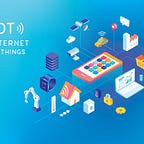Motivation to IOT and Domain of Interest
Hi All,
I am very much excited to write my first blog on what motivated me to investigate IOT.
Introduction to IOT
Internet of things is influencing our lifestyle from the way we react to the way we behave. From air conditioners, that you can control with your smart phone to smart cars providing the shortest route or your smart watch which tracks your daily activities, IOT is a giant network with connected devices. These devices gather and share data about how they are used and the environment in which they are operated. It’s all done using sensors. Sensors are embedded in the physical devices. It can be your mobile phone, electrical appliances, barcode sensors, traffic lights and almost everything that you come across in your day-to-day life. These sensors continuously emit data about the working state of the devices. But the question is how do they share the data? IOT provides a common platform for these devices to dump their data and a common language for all the devices to communicate with each other. Data is emitted from various sensors and sent to IOT platform securely. IOT platfrom integrates the collected data from various sources, further analysis is performed on the data and valuable information is extracted as per requirement. Finally, the result is shared with other devices for better user experience.
Motivation to IOT
In Today’s fast-growing world, possessing a car and learning to drive is a must. But I am very nervous learning to drive a car. Then one of my friends suggested me to take a self-driving car which has an option of autopilot mode. The concept of self-driving cars has already made most of the people to wonder and I am one of them which drove me to research on the history of self-driving cars. The things that we have frequently seen in science fiction movies are getting into our real lives. I was surprised to know that first unmanned road vehicle was made in 1904 by the Spanish inventor Leonardo Torres-Quevedo, which was a radio-controlled vehicle and later it was used as self-destructive bombs during world war I to avoid pushing human into the mission. Then, the first “driverless” car was introduced by Francis Houdina in 1925. In 1956, a version of GM Firebird II was built for detector circuits embedded on highways. In 1958, the Chrysler Imperial was the first car with a cruise control function. In 1994, the Bundeswehr Universitat’s robotic cars VaMP and VITA-2 drove over 600 miles safely. In 2009, Google’s self-driving project began. In 2015, Tesla launched its autopilot software. In 2018, GM completed a self-driving car with no steering wheel or pedals.
Domain Of Interest
That’s how my interest in IOT began and now I wanted to explore in healthcare domain. Since I am computer science student and a software developer, I always end up using most of my time in front of the laptop. So, to make sure that I have some physical activity I started using a fitbit where I could see the number of steps I have walked per day and make sure that I had enough physical activity everyday.
IOT has applications in healthcare that benefit patients, families, hospitals and insurance companies. Devices in the form of wearables like fitness bands and other wirelessly connected devices like blood pressure and heart rate monitoring cuffs, glucometer etc. give patients access to personalized attention. By using wearables and other home monitoring equipment embedded with IoT, physicians can keep track of patients’ health more effectively. They can track patients’ adherence to treatment plans or any need for immediate medical attention. Apart from monitoring patients’ health, there are many other areas where IoT devices are very useful in hospitals. IoT devices tagged with sensors are used for tracking real time location of medical equipment like wheelchairs, defibrillators, nebulizers, oxygen pumps and other monitoring equipment.
I am interested to explore on AWS cloud platform as it is a reliable and secure platform to route the messages to AWS endpoints and other devices.
